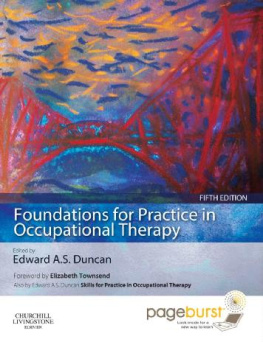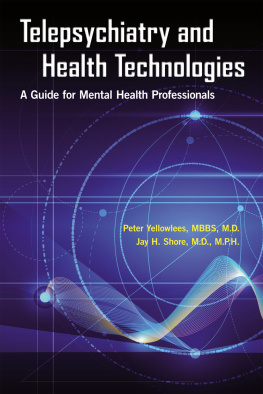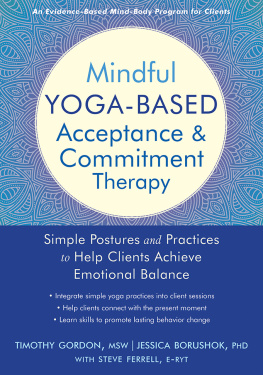Table of Contents
Front matter
Foundations for Practice in Occupational Therapy
Commissioning Editor: Rita Demetriou-Swanwick
Development Editor: Catherine Jackson
Project Manager: Priya Dauntess
Designer/Design Direction: Kirsteen Wright
Illustration Manager: Gillian Richards
Foundations for Practice in Occupational Therapy
FIFTH EDITION
Edited by
Edward A.S. Duncan PhD BSc(Hons) DipCBT
Senior Research Fellow, Nursing, Midwifery and Allied Health Professions Research Unit, University of Stirling, Scotland UK
Foreword by
Elizabeth Townsend PhD OT(C) RegNS FCAOT
Professor Emerita, School of Occupational Therapy, Dalhousie University, Nova Scotia, Canada

Copyright

2011 Elsevier Ltd. All rights reserved.
No part of this publication may be reproduced or transmitted in any form or by any means, electronic or mechanical, including photocopying, recording, or any information storage and retrieval system, without permission in writing from the publisher. Details on how to seek permission, further information about the Publisher's permissions policies and our arrangements with organizations such as the Copyright Clearance Center and the Copyright Licensing Agency, can be found at our website: www.elsevier.com/permissions.
This book and the individual contributions contained in it are protected under copyright by the Publisher (other than as may be noted herein).
First edition 1992
Second edition 1997
Third edition 2001
Fourth Edition 2006
Fifth Edition 2011
ISBN 978 0 7020 3232 5
British Library Cataloguing in Publication Data
A catalogue record for this book is available from the British Library
Library of Congress Cataloging in Publication Data
A catalog record for this book is available from the Library of Congress
Notices
Knowledge and best practice in this field are constantly changing. As new research and experience broaden our understanding, changes in research methods, professional practices, or medical treatment may become necessary.Practitioners and researchers must always rely on their own experience and knowledge in evaluating and using any information, methods, compounds, or experiments described herein. In using such information or methods they should be mindful of their own safety and the safety of others, including parties for whom they have a professional responsibility.With respect to any drug or pharmaceutical products identified, readers are advised to check the most current information provided (i) on procedures featured or (ii) by the manufacturer of each product to be administered, to verify the recommended dose or formula, the method and duration of administration, and contraindications. It is the responsibility of practitioners, relying on their own experience and knowledge of their patients, to make diagnoses, to determine dosages and the best treatment for each individual patient, and to take all appropriate safety precautions.To the fullest extent of the law, neither the Publisher nor the authors, contributors, or editors, assume any liability for any injury and/or damage to persons or property as a matter of products liability, negligence or otherwise, or from any use or operation of any methods, products, instructions, or ideas contained in the material herein.



Printed in China
Dedication
In memory of Dr Gary Wayne Kielhofner (19492010). Gary was a visionary, an exceptional scholar, a modern day father of occupational therapy, and a highly valued colleague. His work changed the life of countless people with disabilities, and formed generations of occupational therapists throughout the world. He will be greatly missed.
Foreword
As I write this Foreword, I am reflecting on the advances made in Foundations for Practice in Occupational Therapy which is the latest edition of Rosemary Hagedorn's classic occupational therapy text. Edited and partly authored by Dr. Edward Duncan of Scotland, Foundations for Practice in Occupational Therapy displays a new milestone in occupational therapists' abilities and insights to articulate what occupational therapists do. Here you will discover the latest views on occupational therapy's complex philosophy, models, frames of reference, and practice possibilities to make a difference in the world. As Dr. Duncan states in Chapter 1: Occupational therapy practice appears deceptively simple[yet]Occupational therapy's theoretical and evidence base is rapidly developing and the profession has entered an exciting new era as therapists become increasingly research-active in a variety of waysfrom collaborating in clinical data collection to acting as a principal investigator.
I am impressed with the comprehensiveness and thoughtfulness of Foundations for Practice in Occupational Therapy . In one compact text, occupational therapy practitioners and others can access the essence of mainstream occupational therapy knowledge and its application in recognizable areas of practice for the 21st century. I liked the tone of Section I's introductory chapters that invite occupational therapists to embrace theory to explain and guide diverse practice applications. The invitation is enriched with reflective notes on the importance of theory and historical insights on external and internal influences that have shaped occupational therapy. I imagine that Section II will be particularly appealing to occupational therapists with chapters that summarize five well known Conceptual Models: The Model of Human Occupation (MOHO); The Canadian Model of Occupational Performance (CMOP); The Person-Environment-Occupational Performance Model (PEOP); The Information Processing Model; and the Kawa (River) Model. The appeal of Sections III and IV will be the concise overviews of five, well-known Frames of Reference and three important, evolving areas of knowledge: clinical reasoning, community-based rehabilitation, and occupational science.
Features that I find helpful in Foundations for Practice in Occupational Therapy are the clear use of language, case studies, examples, figures and tables. This will be a book that can be used over and over again to stimulate discussions and to check for theoretical guidance in the midst of a busy practice. Key Points provided at the beginning of most chapters will help to focus the reader; Reflective Learning questions at the end of chapters will help to engage the reader. I highly recommend this as a concise text that explains occupational therapy to newcomers such as students and to those who know the profession well.
Elizabeth Townsend
2010
Preface
Introduction
Theoretical concepts in occupational therapy provide the cornerstone to practice. Such a position, however, may not be widely held by all members of the profession. As a student, I remember being inspired by the lectures and tutorials that surrounded the theory of occupational therapy. Whilst many of the concepts were not the easiest to grasp, I slowly realized that these theoretical foundations provided rich explanations and frameworks for practice. I found the philosophical basis and conceptual development of occupational therapy inspiring. Practice placements were (mostly) equally inspiring. It was through these experiences that I saw, at first hand, the vital importance of occupation in human life. Theory and practice both inspiring and rich experiences and ones that I continue to treasure as important components of my professional development. Perhaps because of my positive experiences, both academic and practical, I was equally struck by how rarely these concepts connected. I and several of my student peers would often be told, Forget what they tell you in college, this [practice placement] is where you will learn what occupational therapy is really about, or variations on a similar theme. Such experiences were very disheartening, both for us as students and, I'm sure, for our lecturers, who strove to provide an excellent and relevant educational experience. Sadly, this experience was not simply a sign of its times and 20 years on, despite significant theoretical developments with increasingly obvious relevance to practice, and new generations of therapists educated since my time, students continue, at times, to meet the same barriers when they attempt to integrate theory in practice.
Next page















